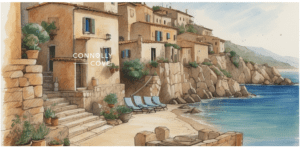Evolution of Irish Pottery: Tracing Its Historical Development

Updated On: May 06, 2024 by Noha Basiouny
As we trace the evolution of Irish pottery, we affirm its place not just as a craft, but as a historical narrative etched into the very clay it is shaped from. The journey begins in ancient times, where the earliest inhabitants of Ireland moulded pottery with the earth at hand, leaving behind a legacy embedded in the Neolithic period. Such artefacts offer invaluable insight into the lives of these peoples, ranging from their daily practices to their ceremonial rites.
Moving forward through history, the pottery traditions in Ireland witnessed a transformation influenced by various cultures, prominently including the arrival of Celtic artistry. This brought forth an amalgamation of local and foreign techniques, giving rise to unique motifs that have become hallmarks of Irish identity. These cultural shifts are central to understanding the evolution of Irish pottery, which not only adapted to changes in aesthetic and form but also reflected Ireland’s socio-economic fabric, especially during pivotal periods such as the medieval and Renaissance eras.
The craft’s saga continues to unfold into the modern age, where historical methods meet contemporary creativity. Irish pottery, with its distinctive marks of quality and cultural symbolism, contributes to the reputation of Ireland’s arts on the global stage, embodying centuries of rich history and evolving creative expression.
Table of Contents
Prehistoric Origins
As we explore the prehistoric origins of Irish pottery, we delve into the remarkable advancements during the Neolithic period and the subsequent developments in the Bronze and Iron Ages. Our understanding of this early chapter is informed by the innovative use of clay in the creation of functional and ceremonial objects, with notable sites such as Labbacallee and various cairns providing crucial archaeological evidence.
Neolithic Innovations
During the Neolithic Period, pottery emerged as a significant craft. Neolithic communities utilised the malleable qualities of clay to create novel pottery forms. These were not merely utilitarian; they held ritual significance as well, with some artefacts found within the context of tombs. One hallmark of this era was the introduction of flat-based pottery, indicative of changing lifestyles from nomadic to settled farming communities.
Bronze and Iron Age Developments
With the advent of the Bronze Age, we witness a transformation in pottery styles. Objects from this period demonstrate an evolution in technique and aesthetics, with finds from various sites intimating a more widespread use of pottery. The Iron Age brought its own developments, marked by a new pottery style identified in the north-east of Ireland, characterised by simplicity and occasional decoration. This ware shows a progression from plain, utilitarian vessels to more elaborately adorned pieces. The Labbacallee wedge tomb and other cairns have contributed valuable insights into the pottery of these periods, affirming the significance of ceramics in the ritual and everyday life.
Celtic Influences and Motifs

In the realm of Irish pottery, the enduring legacy of Celtic art is evident through distinctive decorative elements and profound cultural significance. Curved lines, nature-inspired motifs, and intricate designs not only decorate the pottery but also encapsulate a rich tapestry of ancient traditions.
Celtic Designs in Pottery
The ancient Celts left an indelible mark on pottery decoration, with a penchant for curved lines and nature-themed motifs. This can be keenly observed in the synchrony between the flowing rhythms of their art and the contours of the vessels they adorned. Key patterns derived from plants and animals, alongside famed Celtic knotwork, showcase the Celts’ artistic reach and their closeness with the natural world. Such patterns were not mere decorations but a dialogue between art and utility.
Symbolism and Culture
Beyond aesthetics, the motifs carved onto Celtic pottery vessels bore deeper meanings, linked to the culture and beliefs of the people. Animals were not just figures; they symbolised various aspects of life and the spiritual realm. The interconnectedness of designs, often mirrored in the complex intertwining of lines and shapes, reflected not just artistic flair but also the Celtic view of the interconnectedness of all life. The exchange and evolution of these motifs through trade highlight the dynamic nature of Celtic art, influenced by and influencing the cultures with which the Celts interacted.
Medieval to Renaissance Transitions
As we examine the evolution of Irish pottery, we note significant transitions during the Medieval to Renaissance period, characterised by shifts in power from the Anglo-Normans to the Tudors and changes in pottery forms from purely utilitarian to increasingly decorative.
Anglo-Normans to Tudors
With the arrival of the Anglo-Normans in the late 12th century, Ireland saw a large-scale commencement of medieval pottery production. This era marked by significant trade and societal transformations laid the groundwork for what would become a notable shift in ceramic arts. Archaeological findings suggest the period until the 15th century saw a flourish in pottery that correlated with the Anglo-Norman settlement and influence.
As the Tudor period took hold, new dynamics in Europe influenced Irish pottery. Changes in trade patterns and a burgeoning Renaissance movement across Europe brought about a different appreciation for the arts, including pottery. This led to the diversification of pottery styles and the introduction of more decorative features, blending both the decorative and utilitarian purposes of ceramic wares.
Decorative and Utilitarian Forms
Throughout the Medieval period, Irish pottery predominantly fulfilled utilitarian functions, evident in the commonality of simple, functional forms. Pottery was an essential everyday commodity, made to cater to domestic needs ranging from cooking utensils to storage containers.
However, as we transitioned into the Renaissance, a noticeable shift towards more decorative forms emerged. This was partly due to evolving tastes and the humanistic spirit of the Renaissance that celebrated beauty and artistry in everyday objects. Archaeological finds illustrate a gradual increase in embellishments and variance in pottery shapes, reflecting the changing aesthetic preferences of the time.
In short, the transition from Medieval to Renaissance periods in Ireland mirrors broad European trends and is punctuated by advancements in the art of pottery—from the predominantly Anglo-Norman influenced, utilitarian objects to pieces that showcased aesthetic considerations echoing the Renaissance’s influence on art and culture.
Irish Ceramics in the Modern Age

The modern age saw a significant shift in the creation and perception of Irish ceramics, displaying a transition from traditional methods to a more industrial and global approach.
Industrialisation of Pottery
With the advent of industrialisation, Irish pottery production experienced radical changes. The establishment of factories enabled large-scale manufacturing of ceramic goods, which meant pottery could reach a wider market than ever before. This shift notably led to the emergence of pieces such as Irish Delftware, echoing the influence of Dutch Delftware, cherished for its delicate painting and tin-glaze technique.
Influence of European Trends
European trends heavily influenced Irish pottery, with Irish artisans adapting styles and techniques from Italian Maiolica, French Faience, and Hispano-Moresque Ware. This cross-cultural pollination enriched the Irish ceramic repertoire, allowing it the incorporation of vibrant colours and intricate designs that were a marked departure from earlier simpler styles. In turn, these pieces not only catered to domestic tastes but also attracted an international audience, zealously collecting these unique interpretations.
The Belleek Tradition

In the mid-19th century, Belleek Pottery emerged as a hallmark of craftsmanship and elegance in Irish porcelain. Nestled in the heart of Ireland’s County Fermanagh, it has gained a reputation for its exquisite parian china.
Founding of Belleek Pottery
In 1857, John Caldwell Bloomfield inherited his father’s estate in the Fermanagh area. Determined to provide employment during the famine times, Bloomfield ordered a geological survey on his land. Upon discovering the rich supply of materials suitable for pottery, he founded Belleek Pottery. With the help of Robert Williams Armstrong, an eminent ceramics expert, and talented local craftsmen, they started a pottery business that would later become synonymous with fine Irish porcelain.
Characteristics of Belleek Porcelain
Belleek Porcelain is celebrated for its distinctive features:
- Thinness: The pieces are remarkably thin, giving them a delicate appearance.
- Slightly iridescent surface: This makes for a unique, luminous quality that has captivated collectors.
- Quality: Each piece is crafted to a high standard; a testament to Bloomfield’s proclamation that any item with even the slightest flaw must be destroyed.
The history and enduring legacy of Belleek are rooted in this commitment to excellence and have secured its place as a treasured name in Irish pottery.
Historical Significance

In tracing the evolution of Irish pottery, we uncover a tapestry of cultural heritage that intertwines artefacts and heritage sites with the broader strokes of ceramics in Irish history.
Artefacts and Heritage Sites
Our investigation reveals that pottery pieces serve as poignant relics from past civilisations. In Ireland, ceramics offer a tangible connection to our ancestors. For instance, the Neolithic period is represented through Megalithic Tombs across the isle, some of which contain early examples of pottery. These artefacts are crucial for historians, providing insights into the daily lives and rituals of Ireland’s earliest inhabitants. Sites like the historic County Fermanagh are filled with these remnants, making them significant focal points of Irish Heritage.
Ceramics in Irish History
Moving through history, Irish ceramics have evolved, showing both utilitarian and artistic progress. The establishment of Belleek Pottery in the mid-19th century signifies a turning point when Irish pottery became renowned for its craftsmanship and artistry. This iconic brand has become a parcel of our Cultural Heritage, melding practicality with the elegance that Belleek China is known for today. Our cultural narrative is rich with such transformations, where ceramics are not only practical objects but also symbols of cultural identity and heritage.
Artistic Techniques and Materials

In the evolution of Irish pottery, the mastery of certain techniques and the use of specific materials have played pivotal roles in crafting both functional and ornamental pieces.
Clay Preparation and Firing
Before a potter shapes clay into a vessel, the material undergoes a thoughtful preparation process. We obtain the clay, which is the core substance of both earthenware and stoneware, from the ground. The clay varies in quality and composition—some may include kaolin or feldspar, materials that are essential in making fine bisque porcelain. Once prepared, the clay then has to be fired at high temperatures. The initial firing transforms the clay into a permanent, rigid form known as ‘biscuit’ or ‘bisque’. This stage is critical, as it determines the durability and quality of the pottery.
- Materials used: Clay, Kaolin, Feldspar
- Firing techniques: Bisque firing, final firing
Decorative Techniques
Following the initial firing, we often embellish the biscuit pottery using various decorative techniques. Incising is a method where we etch designs into the clay surface. Additionally, painting allows for a colourful expression on pottery, where we apply various pigments before the final firing. This latter process solidifies the decorative elements, ensuring they are as permanent as the pottery itself. Techniques and materials intertwine to create both simple utility items and complex artistic works.
- Decoration methods: Incised decorations, Painted designs
Evolution of Design and Form
In tracing the evolution of Irish pottery, we see a remarkable journey from simple, utilitarian forms to elaborate pieces of artistry. Our examination will focus on how design and form have been influenced over the centuries, taking cues from both local traditions and global cultural exchanges.
From Utility to Artistry
Initially, pottery served primarily functional purposes, providing storage and cooking vessels to early Irish societies. As time progressed, the aesthetics of these objects became increasingly significant, moving beyond their practical applications. The incorporation of intricate designs and improved techniques in pottery signalled a shift towards valuing these items for their elegance as well as their utility.
Irish potters began to experiment with form, moving from basic shapes to more complex structures, often inspired by the graceful contours found in nature. This transition was marked by the emergence of highly decorative pieces, with embellishments that reflected the potter’s skill and the rise of pottery as a form of artistic expression.
Influence of Global Traditions
The design and form of Irish pottery have been enriched by the assimilation of Mediterranean influences, as early contacts brought new ideas and motifs to Irish shores. Minoan sophistication and Roman finesse provided a wealth of inspiration, embracing novel forms like mould-made vessels that allowed for more uniform and elaborate productions.
These vessels often mirrored the elegance of classical Greek pottery, recognisable in the stylised geometric patterns and the human and mythological figures portrayed in their art. Trade and interaction with Persia and Korea introduced innovative glazing techniques and new forms, which were embraced and adapted by Irish potters to create a distinctive blend that recognised both local and international traditions.
By engaging with a variety of cultural influences, we see a dynamic evolution in the craft of Irish pottery, celebrating both the deep roots of Irish ceramic tradition and the global tapestry of design and form that has shaped its development.
Ceramic Trade and Global Connection

The journey of Irish pottery from local craftsmanship to international renown has been marked by its participation in global trade and the cross-pollination of artistic influences.
Irish Pottery on the International Market
We have seen Irish ceramic goods take their place in the global market, showcasing the culture and craftsmanship of Ireland. The Victorian era marked a particularly strong surge in demand for Irish ceramics. As a result, pieces of Belleek Pottery became highly sought after by collectors around the world due to their delicate and durable nature, often adorned with intricate designs that incorporate bronze, gold, and even thematic elements reminiscent of Greek mythos. The History of Belleek Pottery is an example of this legacy, showcasing how these historically significant ceramics have been exchanged and valued on a global scale.
Exchange of Ideas and Styles
With the exchange of ceramic goods, there came an exchange of ideas and styles between Ireland and the rest of Europe. For instance, Irish potters often drew inspiration from Britain and other European countries, blending traditional motifs with contemporary European trends. This has been evidenced in both historical and modern contexts, where exchange and collaboration have led to unique designs that echo a diverse heritage. Contemporary Irish ceramics also continue to influence and draw from the wider European market, maintaining a robust presence while still holding onto the distinct Irish craftsmanship. Irish Contemporary Ceramics Collection documents the growth and diversification in style, resonant of Ireland’s commitment to cultural dialogue through the medium of clay.
Contemporary Irish Pottery
In this section, we explore the vibrant landscape of modern Irish ceramics, focusing on the people behind the art and the innovative trends that define today’s pottery scene in Ireland.
Modern Makers and Studios
Ireland’s contemporary pottery scene is a dynamic blend of traditional techniques and modern aesthetics. Highly skilled artists like Louis Mulcahy have become intrinsic to Ireland’s cultural fabric, continuing the legacy with his studio in Dingle, County Kerry. These studios are not only places of production but also serve as learning centres for aspiring potters, fostering a community centred around ceramic arts. Across Ireland, studios in places such as Carrigaline offer a range of stoneware that captures the essence of Irish tradition while embracing contemporary design.
Current Trends and Innovations
Contemporary Irish ceramics embrace both the aesthetic qualities of pottery and its functional aspects. Innovations in firing techniques and decoration have allowed for a wider range of colours and textures, with many artists experimenting to find unique expressions. There’s a growing trend of merging new technologies, like digital ceramic printing, with age-old crafting techniques. The Irish Contemporary Ceramics Collection is a testament to the evolution of this art form, showcasing works that challenge and redefine what’s possible in Irish pottery.
This dynamic mix of traditional roots and innovative perspectives ensures that contemporary Irish pottery continues to thrive, contributing to Ireland’s rich tapestry of art and culture.
FAQs
As experts in the enduring craft of Irish pottery, we’re here to shed light on your most pressing queries about this rich artistic tradition that has thrived from ancient times to the modern era.
1. How has Irish pottery developed from ancient times to the present day?
Irish pottery has transitioned significantly since its emergence in the Neolithic period, where it served primary utilitarian functions. Over millennia, this craft has undergone revivals and modernisation while preserving traditional techniques, giving us a vibrant tapestry that melds the ancient with the contemporary.
2. What are the distinguishing features of traditional Celtic pottery designs?
Traditional Celtic pottery is often recognised for its understated yet sophisticated designs. It typically features dark colours, like blacks and browns, with vessels being well-finished and highly polished, often emulating the shapes of metalwork with volute or S-shaped handles.
3. Can you trace the origins and growth of Belleek Pottery in Ireland?
Belleek Pottery, founded in 1857 in County Fermanagh, marks a significant chapter in Irish pottery. It is renowned for its intricate designs and delicate craftsmanship, reflecting Ireland’s resilience, creativity, and enterprise through centuries.
4. What are some prominent types of pottery that originated in Ireland?
Notable types of Irish pottery include the world-famous Belleek, known for its Parian china, and the robust stoneware from the likes of Louis Mulcahy. Other forms encompass both functional and decorative pieces that often draw on Ireland’s Celtic heritage for inspiration.
5. How did the cultural and historical context of Ireland influence its pottery styles?
Ireland’s tumultuous history, rich folklore, and rural traditions have deeply influenced its pottery. The country’s struggles and victories, alongside its intimate connection with nature, have been etched into the very clay, capturing the essence of Irish life and tradition in pottery.
6. What role did pottery play in the daily and ceremonial lives of the ancient Celts?
For the ancient Celts, pottery was an essential part of everyday life, used for cooking, storage, and as heirlooms. It also held ceremonial significance, with certain designs reserved for rituals and offerings, signifying the integral role pottery held within the Celtic society.






